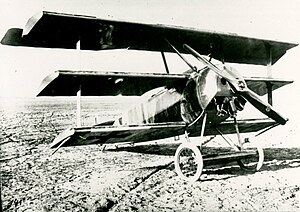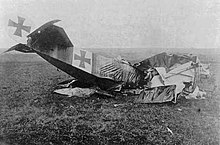Fokker Dr.I
| Fokker Dr.I | |
|---|---|

| |
| Fokker Dr.I | |
| Role | Fighter |
| Manufacturer | Fokker-Flugzeugwerke |
| Designer | Reinhold Platz |
| First flight | July 5, 1917 |
| Primary user | |
| Number built | 320[1] |
| Developed from | Fokker V.4 Fokker F.I |
| Variants | Fokker V.7 |
The Fokker Dr.I (Dreidecker, "triplane" in German), often known simply as the Fokker Triplane, was a World War I fighter aircraft built by Fokker-Flugzeugwerke. The Dr.I saw widespread service in the spring of 1918. It became famous as the aircraft in which Manfred von Richthofen gained his last 17 victories (plus two earlier ones in the Fokker F.I prototype in September 1917), and in which he was killed on 21 April 1918.
Design and development

In February 1917, the
Instead of submitting the V.4 for a type test, Fokker produced a revised prototype designated
Operational history
The first two pre-production triplanes were designated
Richthofen first flew 102/17 on 1 September 1917 and shot down two enemy aircraft in the next two days. He reported to the Kogenluft (Kommandierender General der Luftstreitkräfte) that the F.I was superior to the Sopwith Triplane.
The remaining pre-production aircraft, designated Dr.I, were delivered to Jasta 11.
Compared with the Albatros and Pfalz fighters, the Dr.I offered exceptional maneuverability. Though the ailerons were not very effective, the rudder and elevator controls were light and powerful.[15] Rapid turns, especially to the right, were facilitated by the triplane's marked directional instability.[15] Vizefeldwebel Franz Hemer of Jasta 6 said, "The triplane was my favorite fighting machine because it had such wonderful flying qualities. I could let myself stunt – looping and rolling – and could avoid an enemy by diving with perfect safety. The triplane had to be given up because although it was very maneuverable, it was no longer fast enough."[16]

As Hemer noted, the Dr.I was considerably slower than contemporary Allied fighters in level flight and in a dive. While initial rate of climb was excellent, performance fell off dramatically at higher altitudes because of the low compression of the
The Dr.I suffered other deficiencies. The pilot's view was poor during takeoff and landing.[19] The cockpit was cramped and furnished with materials of inferior quality.[20] Furthermore, the proximity of the gun butts to the cockpit, combined with inadequate crash padding, left the pilot vulnerable to serious head injury in the event of a crash landing.[21]
Wing failures

On 29 October 1917, Leutnant der Reserve
In response to the crash investigation, Fokker was forced to improve quality control on the production line, particularly varnishing of the
Despite corrective measures, the Dr.I continued to suffer from wing failures. On 3 February 1918, Leutnant Hans Joachim Wolff of Jasta 11 successfully landed after suffering a failure of the upper wing leading edge and ribs.
Postwar research revealed that poor workmanship was not the only cause of the triplane's structural failures. In 1929, National Advisory Committee for Aeronautics (NACA) investigations found that the upper wing carried a higher lift coefficient than the lower wing – at high speeds it could be 2.55 times as much.
The triplane's chronic structural problems destroyed any prospect of large-scale orders.[30] Production eventually ended in May 1918, by which time only 320 had been manufactured.[31] The Dr.I was withdrawn from frontline service as the Fokker D.VII entered widespread service in June and July. Jasta 19 was the last squadron to be fully equipped with the Dr.I.[32]
Surviving triplanes were distributed to training and home defense units. Several training aircraft were reengined with the 75 kW (100 hp) Goebel Goe.II.

Experimental engines
Several Dr.Is were used as testbeds for experimental engines. One aircraft, designated V.7, was fitted with the Siemens-Halske Sh.III bi-rotary engine.[35] The V.7 exhibited exceptional rate of climb and ceiling, but it proved difficult to handle.[35] Serial 108/17 was used to test the 118 kW (160 hp) Goebel Goe. III, while serial 469/17 was used to test the 108 kW (145 hp) Oberursel Ur. III.[36] None of these engines were used on production aircraft. One triplane was used as a testbed for an experimental Schwade gear-driven supercharger.
Postwar
Three triplanes are known to have survived the Armistice. Serial 528/17 was retained as a testbed by the Deutschen Versuchsanstalt für Luftfahrt (German Aviation Research Institute) at Adlershof. After being used in the filming of two movies, 528/17 is believed to have crashed sometime in the late 1930s.[37] Serial 152/17, in which Manfred von Richthofen obtained three victories, was displayed at the Zeughaus museum in Berlin.[37] This aircraft was destroyed in an Allied bombing raid during World War II.
In 1932, Fokker assembled a Dr.I from existing components. It was displayed in the Deutsche Luftfahrt-Sammlung in Berlin. In 1943, the aircraft was destroyed in an Allied bombing raid. Today, only a few original Dr.I artifacts survive in museums.
Variants
- V.4 – Initial prototype
- V.5 – First production prototype
- V.6 – Enlarged prototype with Mercedes D.II engine
- V.7 – Prototype with Siemens-Halske Sh.III engine
- Vagel Grip SP.5 Greif - German post-war two seat copy of the Dr.I
Operators
Replica and reproduction aircraft

Large numbers of replica and reproduction aircraft have been built for both individuals and museums. Bitz Flugzeugbau GmbH built two Dr.I replicas, serial numbers 001 and 002, for use in
Specifications (Dr.I)

Data from Quest for Performance.[41]
General characteristics
- Crew: 1
- Length: 5.77 m (18 ft 11 in)
- Upper wingspan: 7.19 m (23 ft 7 in)
- Height: 2.95 m (9 ft 8 in)
- Wing area: 18.7 m2 (201 sq ft)
- Aspect ratio: 4.04
- Empty weight: 406 kg (895 lb)
- Gross weight: 586 kg (1,291 lb)
- Powerplant: 1 × Oberursel Ur.II9-cylinder air-cooled rotary piston engine, 82 kW (110 hp)
- Propellers: 2-bladed fixed-pitch wooden propeller
Performance
- Maximum speed: 180 km/h (110 mph, 97 kn) at 2600m
- Stall speed: 72 km/h (45 mph, 39 kn)
- Range: 300 km (190 mi, 160 nmi)
- Service ceiling: 6,100 m (20,000 ft)
- Rate of climb: 5.7 m/s (1,120 ft/min)
- Lift-to-drag: 8:1
- Wing loading: 31.0 kg/m2 (6.3 lb/sq ft)
- Zero-lift drag coefficient: 0.0323
- Frontal area at zero-lift drag coefficient: 0.62 m2 (6.7 sq ft)
Armament
- Guns: 2 × 7.92 mm (0.312 in) Maschinengewehr 08"Spandau" machine guns
See also
- Airdrome Fokker DR-1, homebuilt replica
- Redfern Fokker Dr.1, homebuilt replica
- Sands Fokker Dr.1 Triplane, homebuilt replica
Aircraft of comparable role, configuration, and era
References
- ^ Rimell, 1996, pp.1 & 21
- ^ Franks 2004, p. 9.
- ^ Franks 2004, p. 21.
- ^ Leaman 2003, pp. 30, 32.
- ^ Weyl 1965, p.223.
- ^ Leaman 2003, p. 34.
- ^ Weyl 1965, p. 226.
- ^ Weyl 1965, p. 228.
- ^ Weyl 1965, p. 229.
- ^ Weyl 1965, p. 231.
- ^ a b Weyl 1965, p. 232.
- ^ Leaman 2003, p. 53.
- ^ a b Franks and VanWyngarden 2001, p. 22.
- ^ Leaman 2003, p. 96.
- ^ a b Leaman 2003, p. 95.
- ^ VanWyngarden 2004, p. 75.
- ^ Nowarra 1990, p. 12.
- ^ Franks and VanWyngarden 2001, p. 83.
- ^ Weyl 1965, p. 245.
- ^ Weyl 1965, pp. 244–245.
- ^ Weyl 1965, p. 410.
- ^ a b Weyl 1965, p. 233.
- ^ a b Weyl 1965, pp. 233–234.
- ^ Weyl 1965, pp. 236, 239.
- ^ Weyl 1965, p. 235.
- ^ Weyl 1965, pp. 238–239.
- ^ Franks and VanWyngarden 2001, p. 55.
- ^ Franks and VanWyngarden 2001, p. 25.
- ^ Franks and VanWyngarden 2001, pp. 26–27.
- ^ Weyl 1965, p. 236.
- ^ Gray and Thetford 1962, p. 100.
- ^ Leaman 2003, p. 69.
- ^ Leaman 2003, p. 222.
- ^ a b Weyl 1965, p. 246.
- ^ a b Weyl 1965, p. 248.
- ^ Weyl 1965, pp. 249–250.
- ^ a b Leaman 2003, p. 181.
- ^ Nowarra 1990, p. 47.
- ^ "Cole Palen's Old Rhinebeck Aerodrome — Fokker Dr.1 Triplane". oldrhinebeck.org. Old Rhinebeck Aerodrome. 24 February 2021. Retrieved May 12, 2021.
- ^ "Oberursel UR.II" The Vintage Aviator. Retrieved: 6 November 2016.
- ^ Loftin 2004, Table I.
Sources
- Franks, Norman. Sopwith Triplane Aces of World War I (Aircraft of the Aces No. 62). Oxford: Osprey Publishing, 2004. ISBN 1-84176-728-X.
- Franks, Norman and Greg VanWyngarden. Fokker Dr.I Aces of World War I (Aircraft of The Aces No. 40). Oxford: Osprey Publishing, 2001. ISBN 1-84176-223-7.
- Gray, Peter and Owen Thetford. German Aircraft of the First World War. London: Putnam, 1962. ISBN 0-933852-71-1
- Grosz, Peter & Ferko, Alain E. (December 1988). "Le Fokker Dr I mis au point (4)" [Fokker Dr I Development, Part 4]. Le Fana de l'Aviation (in French) (249): 36–38. ISSN 0757-4169.
- Herris, Jack & Phillips, Taz (2021). Fokker Aircraft of WWI: Volume 4: V.1–V.8, F.I & Dr.I: A Centennial Perspective on Great War Airplanes. Great War Aviation Centennial Series. Vol. 54. n.p.: Aeronaut Books. ISBN 978-1-953201-08-9.
- Imrie, Alex (1978-07-15). German Fighter Units June 1917 - 1918. London: Osprey Publishing Limited, 1978. ISBN 0-85045-289-9.
- Imrie, Alex (1986). Fokker Fighters Of World War One. London: Arms and Armour Press, 1986. ISBN 0-85368-782-X.
- Imrie, Alex. The Fokker Triplane. Arms and Armour Press, 1992. ISBN 1-85409-118-2.
- Leaman, Paul. Fokker Dr.I Triplane: A World War One Legend. Hersham, Surrey, UK: Classic Publications, 2003. ISBN 1-903223-28-8.
- Loftin Jr., Laurence K. Quest for Performance: The Evolution of Modern Aircraft. NASA Scientific and Technical Information Branch, 2004. Retrieved on 22 April 2006.
- Nowarra, Heinz J. Fokker Dr.I In Action (Aircraft No. 98). Carrollton, TX: Squadron/Signal Publications, Inc., 1990. ISBN 0-89747-229-2.
- Rimell, Raymond Laurence (1996). Fokker Triplane. Windsock Datafiles 5. Herts, UK: Albatros Productions. ISBN 978-0948414039.
- VanWyngarden, Greg. Richthofen's Flying Circus: Jagdgeschwader Nr I (Aviation Elite Units No. 16). Oxford: Osprey Publishing, 2004. ISBN 1-84176-726-3.
- Weyl, A.R. Fokker: The Creative Years. London: Putnam, 1965. ISBN 0-85177-817-8.
